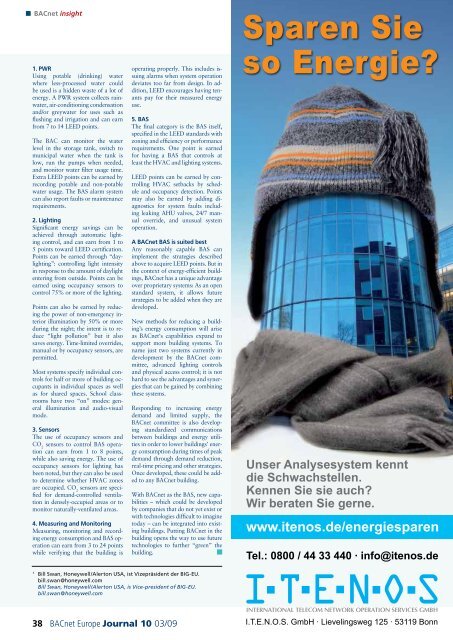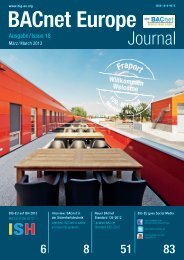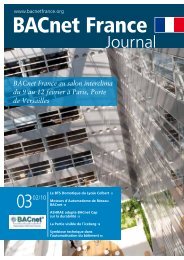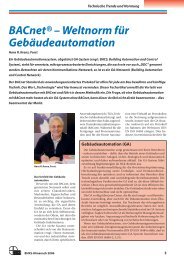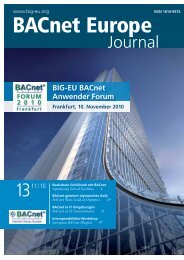1003/09 BACnet Standard erweitert
1003/09 BACnet Standard erweitert
1003/09 BACnet Standard erweitert
Erfolgreiche ePaper selbst erstellen
Machen Sie aus Ihren PDF Publikationen ein blätterbares Flipbook mit unserer einzigartigen Google optimierten e-Paper Software.
<strong>BACnet</strong> insight<br />
1. PWR<br />
Using potable (drinking) water<br />
where less-processed water could<br />
be used is a hidden waste of a lot of<br />
energy. A PWR system collects rainwater,<br />
air-conditioning condensation<br />
and/or greywater for uses such as<br />
flushing and irrigation and can earn<br />
from 7 to 14 LEED points.<br />
The BAC can monitor the water<br />
level in the storage tank, switch to<br />
municipal water when the tank is<br />
low, run the pumps when needed,<br />
and monitor water filter usage time.<br />
Extra LEED points can be earned by<br />
recording potable and non-potable<br />
water usage. The BAS alarm system<br />
can also report faults or maintenance<br />
requirements.<br />
2. Lighting<br />
Significant energy savings can be<br />
achieved through automatic lighting<br />
control, and can earn from 1 to<br />
5 points toward LEED certification.<br />
Points can be earned through “daylighting”:<br />
controlling light intensity<br />
in response to the amount of daylight<br />
entering from outside. Points can be<br />
earned using occupancy sensors to<br />
control 75% or more of the lighting.<br />
Points can also be earned by reducing<br />
the power of non-emergency interior<br />
illumination by 50% or more<br />
during the night; the intent is to reduce<br />
“light pollution” but it also<br />
saves energy. Time-limited overrides,<br />
manual or by occupancy sensors, are<br />
permitted.<br />
Most systems specify individual controls<br />
for half or more of building occupants<br />
in individual spaces as well<br />
as for shared spaces. School classrooms<br />
have two “on” modes: general<br />
illumination and audio-visual<br />
mode.<br />
3. Sensors<br />
The use of occupancy sensors and<br />
CO 2 sensors to control BAS operation<br />
can earn from 1 to 8 points,<br />
while also saving energy. The use of<br />
occupancy sensors for lighting has<br />
been noted, but they can also be used<br />
to determine whether HVAC zones<br />
are occupied. CO 2 sensors are specified<br />
for demand-controlled ventilation<br />
in densely-occupied areas or to<br />
monitor naturally-ventilated areas.<br />
4. Measuring and Monitoring<br />
Measuring, monitoring and recording<br />
energy consumption and BAS operation<br />
can earn from 3 to 24 points<br />
while verifying that the building is<br />
operating properly. This includes issuing<br />
alarms when system operation<br />
deviates too far from design. In addition,<br />
LEED encourages having tenants<br />
pay for their measured energy<br />
use.<br />
5. BAS<br />
The final category is the BAS itself,<br />
specified in the LEED standards with<br />
zoning and efficiency or performance<br />
requirements. One point is earned<br />
for having a BAS that controls at<br />
least the HVAC and lighting systems.<br />
LEED points can be earned by controlling<br />
HVAC setbacks by schedule<br />
and occupancy detection. Points<br />
may also be earned by adding diagnostics<br />
for system faults including<br />
leaking AHU valves, 24/7 manual<br />
override, and unusual system<br />
operation.<br />
A <strong>BACnet</strong> BAS is suited best<br />
Any reasonably capable BAS can<br />
implement the strategies described<br />
above to acquire LEED points. But in<br />
the context of energy-efficient buildings,<br />
<strong>BACnet</strong> has a unique advantage<br />
over proprietary systems: As an open<br />
standard system, it allows future<br />
strategies to be added when they are<br />
developed.<br />
New methods for reducing a building’s<br />
energy consumption will arise<br />
as <strong>BACnet</strong>‘s capabilities expand to<br />
support more building systems. To<br />
name just two systems currently in<br />
development by the <strong>BACnet</strong> committee,<br />
advanced lighting controls<br />
and physical access control; it is not<br />
hard to see the advantages and synergies<br />
that can be gained by combining<br />
these systems.<br />
Responding to increasing energy<br />
demand and limited supply, the<br />
<strong>BACnet</strong> committee is also developing<br />
standardized communications<br />
between buildings and energy utilities<br />
in order to lower buildings’ energy<br />
consumption during times of peak<br />
demand through demand reduction,<br />
real-time pricing and other strategies.<br />
Once developed, these could be added<br />
to any <strong>BACnet</strong> building.<br />
With <strong>BACnet</strong> as the BAS, new capabilities<br />
– which could be developed<br />
by companies that do not yet exist or<br />
with technologies difficult to imagine<br />
today – can be integrated into existing<br />
buildings. Putting <strong>BACnet</strong> in the<br />
building opens the way to use future<br />
technologies to further “green” the<br />
building.<br />
1 Bill Swan, Honeywell/Alerton USA, ist Vizepräsident der BIG-EU.<br />
bill.swan@honeywell.com<br />
Bill Swan, Honeywell/Alerton USA, is Vice-president of BIG-EU.<br />
bill.swan@honeywell.com<br />
38<br />
<strong>BACnet</strong> Europe Journal 10 03/<strong>09</strong><br />
Sparen Sie<br />
so Energie?<br />
Unser Analysesystem kennt<br />
die Schwachstellen.<br />
Kennen Sie sie auch?<br />
Wir beraten Sie gerne.<br />
www.itenos.de/energiesparen<br />
Tel.: 0800 / 44 33 440 · info@itenos.de<br />
I.T.E.N.O.S. GmbH · Lievelingsweg 125 · 53119 Bonn


